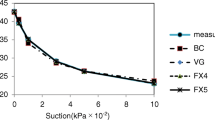Abstract
To prevent the leakage of pollutant liquids into groundwater and sublayers, the compacted fine-grained soils are commonly utilized as mineral liners or a sealing system constructed under municipal solid waste and other containment hazardous materials. This study presents the correlation equations of the compaction parameters required for construction of a mineral liner system. The determination of the characteristic compaction parameters, maximum dry unit weight (γ dmax) and optimum water content (w opt) requires considerable time and great effort. In this study, empirical models are described and examined to find which of the index properties correlate well with the compaction characteristics for estimating γ dmax and w opt of fine-grained soils at the standard compactive effort. The compaction data are correlated with different combinations of gravel content (G), sand content (S), fine-grained content (FC = clay + silt), plasticity index (I p), liquid limit (w L) and plastic limit (w P) by performing multilinear regression (MLR) analyses. The obtained correlations with statistical parameters are presented and compared with the previous studies. It is found that the maximum dry unit weight and optimum water content have a considerably good correlation with plastic limit in comparison with liquid limit and plasticity index.







Similar content being viewed by others
References
ASTM D-698 (2003) Standard test methods for laboratory compaction characteristics of soil using standard effort. ASTM International 100 Barr Harbor Drive, PO Box C700, West Conshohocken, United States
Benson C, Trast JM (1995) Hydraulic conductivity of thirteen compacted clays. Clays Clay Miner 43(6):669–681
Benson CH, Daniel DE, Boutwell GP (1999) Field performance of compacted clay liners. J Geotech Geoenviron Eng 125(5):390–403
Blotz RL, Benson H, Boutwell P (1998) Estimating optimum water content and maximum dry unit weight for compacted clays. ASCE J Geotech Geoenviron Eng 124(9):907–912
Daniel D, Benson C (1990) Water content–density criteria for compacted soil liners. ASCE J Geotech Eng 116(12):1181–1190
Daniel D, Wu Y (1993) Compacted clay liners and covers for arid sites. ASCE J Geotech Eng 119(2):223–237
Davidson DT, Gardiner WF (1949) Calculation of standard proctor density and optimum moisture content from mechanical, analysis, shrinkage factors and plasticity index: Highway research bulletin no. 29. Highway Research Board National Research Council, Washington DC, pp 447–481
Foreman ED, Daniel DE (1986) Permeation of compacted clay with organic chemicals. ASCE J Geotech Eng 112(7):669–681
Gurtug Y, Sridharan A (2004) Compaction behaviour and prediction of its characteristics of fine grained soils with particular reference to compaction energy. Soil Found 44(5):27–36
Hanson DJ (1989) Hazardous waste management: planning to avoid future problems. Chem Eng News 21(7):6–32
Jeng YS, Strohm WE (1976) Prediction of the shear strength and compaction characteristics of compacted fine-grained cohesive soils. Final report, U.S. Army Engineer Waterways Experiment Station. Soils and Pavement Laboratory, Vicksburg, MO, USA
Johnson AW, Sallberg JR (1960) Factors that influence compaction of soils. Highway research board, no. 272. National Academy of Sciences, Washington, DC
Johnson AW, Sallberg JR (1962) Factors influencing compaction results. Highway research board bulletin, no. 319. National Academy of Sciences, Washington, DC
Joslin JC (1958) Ohio’s typical moisture–density curves. ASTM STP 239:111–118
Jumikis A (1958) Geology and soils of the Newark (N.J.) metropolitan area. ASCE J Soil Mech Found Div 94(2)
Kayadelen C (2007) The consolidation characteristics of an unsaturated compacted soil. Environ Geol, Springer, Heidelberg. doi:10.1007/s00254-007-0819-2
Lambe TW (1958) The engineering behavior of compacted clay. ASCE J Soil Mech and Foundation Div SM2 84(1655):1–35
Mitchell JK, Hooper DR, Campanella RG (1965) Permeability of compacted clay. ASCE J Soil Mech Found Div 91(4):41–65
McRae JL (1958) Index of compaction characteristics. ASTM STP 239:119–127
Ramiah B, Viswanath V, Krishnamurthy H (1970) Interrelationship of compaction and index properties. In: Balkema AA (ed) Proceedings of 2nd Southeast Asian Conference on Soil Engineering, Rotterdam, The Netherlands, pp 577–587
Ring GW, Sallberg JR, Collins WH (1962) Correlation of compaction and classification test data. Highway research bulletion no. 325. Highway Research Board National Research Council, Washington, DC, pp 55–75
Rowan HW, Graham WW (1948) Proper compaction eliminates curing period in construction fills. Civil Eng 18:450–451
Rowe RK (2001) Geotechnical and geoenvironmental engineering handbook. Kluwer, USA
Sridharan A, Nagaraj HB (2005) Plastic limit and compaction characteristics of fine-grained soils. Ground Improv 9(1):17–22
Sridharan A, Rao SM, Sanjeev J (1990) Classification of expansive soils by sediment volume method. Geotech Test J 13(4):375–380
Sridharan A, Pandian NS, Srinivas S (2001) Compaction behaviour of Indian coal ashes. Ground Improv 5(1):13–22
Turnbull JM (1948) Computation of the optimum moisture content in the moisture–density relationship of soils. In: Balkema AA (ed) Proceedings of the 2nd international conference on soil mechanics and foundation engineering, vol IV, Rotterdam, The Netherlands, pp 256–262
Wang M, Huang C (1984) Soil compaction and permeability prediction models. ASCE J Environ Eng 110(6):1063–1083
Acknowledgments
I would like to express my sincere thanks to Prof. Dr. Ergun Togrol, the former president of the Division of Geotechnical Engineering, Faculty of Civil Engineering, Istanbul Technical University, for his precious help in the preparation of the paper.
Author information
Authors and Affiliations
Corresponding author
Rights and permissions
About this article
Cite this article
Sivrikaya, O. Models of compacted fine-grained soils used as mineral liner for solid waste. Environ Geol 53, 1585–1595 (2008). https://doi.org/10.1007/s00254-007-1142-7
Received:
Accepted:
Published:
Issue Date:
DOI: https://doi.org/10.1007/s00254-007-1142-7




